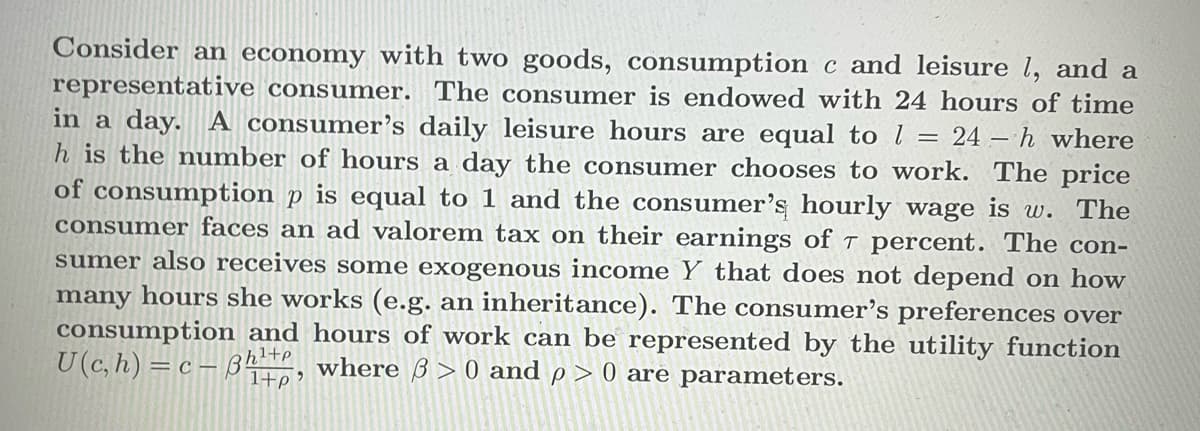Consider an economy with two goods, consumption c and leisure 1, and a representative consumer. The consumer is endowed with 24 hours of time in a day. A consumer's daily leisure hours are equal to 1 = 24-h where h is the number of hours a day the consumer chooses to work. The price of consumption p is equal to 1 and the consumer's hourly wage is w. The consumer faces an ad valorem tax on their earnings of 7 percent. The con- sumer also receives some exogenous income Y that does not depend on how many hours she works (e.g. an inheritance). The consumer's preferences over consumption and hours of work can be represented by the utility function U(c, h) = c-3h¹t, where ß>0 and p > 0 are parameters. 1+p
Consider an economy with two goods, consumption c and leisure 1, and a representative consumer. The consumer is endowed with 24 hours of time in a day. A consumer's daily leisure hours are equal to 1 = 24-h where h is the number of hours a day the consumer chooses to work. The price of consumption p is equal to 1 and the consumer's hourly wage is w. The consumer faces an ad valorem tax on their earnings of 7 percent. The con- sumer also receives some exogenous income Y that does not depend on how many hours she works (e.g. an inheritance). The consumer's preferences over consumption and hours of work can be represented by the utility function U(c, h) = c-3h¹t, where ß>0 and p > 0 are parameters. 1+p
Chapter16: Labor Markets
Section: Chapter Questions
Problem 16.1P
Related questions
Question

Transcribed Image Text:Consider an economy with two goods, consumption c and leisure 1, and a
representative consumer. The consumer is endowed with 24 hours of time
in a day. A consumer's daily leisure hours are equal to 1 = 24-h where
h is the number of hours a day the consumer chooses to work. The price
of consumption p is equal to 1 and the consumer's hourly wage is w. The
consumer faces an ad valorem tax on their earnings of 7 percent. The con-
sumer also receives some exogenous income Y that does not depend on how
many hours she works (e.g. an inheritance). The consumer's preferences over
consumption and hours of work can be represented by the utility function
U(c, h) = c-3h¹+, where 3 > 0 and p > 0 are parameters.
1+p

Transcribed Image Text:(a) What is this consumer's budget constraint?
(b) Solve for the consumer's utility maximizing hours of work h* (w, 1-7) and consump-
tion c* (w, 1-7, Y).
Expert Solution
This question has been solved!
Explore an expertly crafted, step-by-step solution for a thorough understanding of key concepts.
This is a popular solution!
Trending now
This is a popular solution!
Step by step
Solved in 3 steps

Knowledge Booster
Learn more about
Need a deep-dive on the concept behind this application? Look no further. Learn more about this topic, economics and related others by exploring similar questions and additional content below.Recommended textbooks for you

